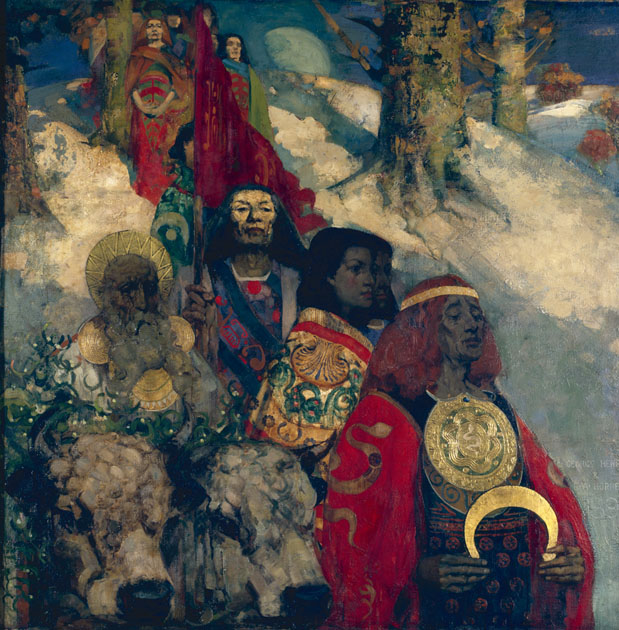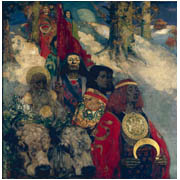Details
- Object type
painting
- Title
The Druids - Bringing in the Mistletoe
- Artist/Maker
George Henry artist
Edward Atkinson Hornel artist
- Culture/School
Glasgow Boys
- Date
1890
- Materials
oil on canvas
- Dimensions
framed: 1983 x 1983 x 90 mm;unframed: 1524 mm x 1524 mm
- Description
-
In this nocturnal scene, Celtic priests or Druids in richly decorated ceremonial robes solemnly process down a wooded, snow-clad hillside in the moonlight. This painting is one of two collaborative works Glasgow Boy painters George Henry and E. A. Hornel produced in 1890–91, the other being Star in the East (1891). Of the Boys, Hornel was the most drawn to Scottish archaeology and Celtic folklore and he probably suggested the subject matter of this visionary painting depicting the Celtic religious rite of bringing in the sacred mistletoe. The mistletoe, having been cut from the sacred oak by a golden sickle held by the Druid leading the procession, is being reverently carried on the backs of two white bulls, who will later be sacrificed. Mistletoe is significant as a plant revered by the druids for its magical as well as medicinal properties – it was thought to cure infertility and act as an antidote to poison.
Hornel’s library included a large number of books, articles, newspaper cuttings and pamphlets about Scottish history, archaeology and antiquities, particularly as associated with the Galloway landscape where he lived. Hornel’s research is evident in this painting. For example, the patterns on robes were inspired by Pictish designs found on early carved stones in Scotland. Hornel was particularly obsessed with ancient cup-and-ring markings, and, according to the artist A. S. Hartrick, would go to any lengths to find these Bronze Age carvings. On one occasion Hartrick related that Hornel took him to see some examples near the cottage of a local character named Sinclair. During this visit the old man went into a kind of trance and began to describe ‘a vision of a procession of priests with sacred instruments and cattle which somehow were connected with the cup-and-ring markings.’ This vision was inspirational for The Druids. In preparation for this painting the artists also examined druidical skulls and the Duke of Hamilton’s herd of ancient white cattle.
From the late 1880s the paintings of both Henry and Hornel became increasingly decorative and symbolic, with little traditional perspective, rich colour and patterning. Here the high horizon-line flattens the composition. Henry and Hornel’s use of gold leaf over incised gesso enhances its ornamental quality, as well as adding to the sense of sacred mysticism. The Belgian poet and critic, Emile Verhaeren, reviewing the painting in 1891, saw it as directly related to the works of Italian Renaissance masters Crivelli, Lorenzo da San Severino and Foppa on display at the National Gallery in London. The frame is decorated with a Celtic knotwork design. More and more artists in this period were getting involved in frame design, seeing the frame as part of the overall aesthetic effect. This painting is part of a revival of interest in Celtic history and Gaelic culture in Scotland from the late 1880s which was to have a major impact on contemporary art and design.
Exhibited in the Grosvenor Gallery in 1890, the painting was ‘skied’ yet attracted much attention and was considered the most important Glasgow painting in the exhibition. It resulted in the Glasgow Boys being invited to exhibit at the Munich Art Society exhibition in the Glaspalaste, Munich later that year, an exhibition which helped establish their international reputation. After this the Boys were invited to exhibit throughout Europe and America.
- Credit Line/Donor
Purchased, 1922
- ID Number
1534
- Location
Kelvingrove Scottish Art


